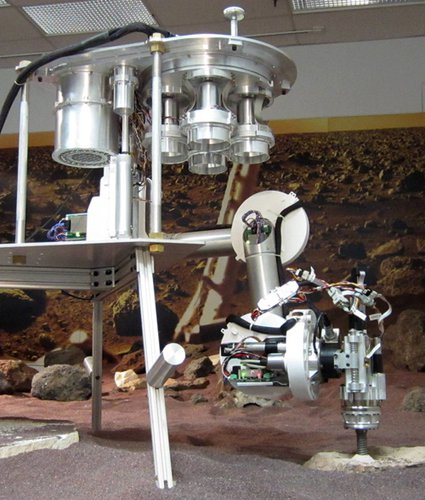
Sample acquisition and caching is accomplished utilizing the Sample Acquisition Tool (SAT) which will be deployed to the surface by the Robotic Arm, and the Sample Handling, Encapsulation, and Containerization (SHEC) mechanism which will be mounted on the rover body. Hardware prototypes of a robotic arm, SAT, and SHEC are shown in the accompanying figure.
NASA and the European Space Agency are working together on a Mars 2018 Joint Rover Mission to potentially send a rover to Mars to perform in-situ exploration and to collect samples for return to Earth in a subsequent mission. This task is developing a technology readiness level (TRL) 6 version of the Sample Acquisition and Caching (SAC) subsystem for the mission. The SAC subsystem would acquire rock core and soil samples and store them in a sample cache canister. The canister would be placed on the ground after being filled with samples. A subsequent mission would retrieve the cache canister and load it into a Mars Ascent Vehicle (MAV) which would launch it in the next step toward its eventual return to Earth.
Sample acquisition and caching is accomplished utilizing the Sample Acquisition Tool (SAT) which will be deployed to the surface by the Robotic Arm, and the Sample Handling, Encapsulation, and Containerization (SHEC) mechanism which will be mounted on the rover body. Hardware prototypes of a robotic arm, SAT, and SHEC are shown in the accompanying figure.
The SAT has the following functions: coring, core break-off, core retention, and bit capture/release. The SAT utilizes rotary percussion for sampling and employs a passive linear spring to impart weight on bit and provide linear feed during coring. The spring is reset various times during a coring operation by the robotic arm. The SAT may additionally provide functionality for brushing and abrading of sample surfaces by being able to attach one or more specialized bits for brushing and abrading.
The SHEC includes a bit carousel for bit change-out, a transfer arm for transferring sample tubes between the sample and bit carousels, a cache canister in the center of the sample carousel where samples would be stored in sealed tubes, and tube plugs and spare tubes on the outer rings of the sample carousel. The SHEC design enables close-packed storage of samples in a cache canister such that the cache canister can be the canister returned to Earth in a subsequent mission without the need for repackaging of the samples.
The product of sample acquisition and caching is a filled cache canister placed on the surface of Mars. A filled cache canister can be removed from the SHEC via a door on top of the SHEC. The cache canister is anticipated to have the same mechanical interface as a sampling bit so the robotic arm can mate the SAT with the cache handle and pull the cache canister out the top of the SHEC and then place the cache canister on the ground.
People on this Task
Paulo Younse


